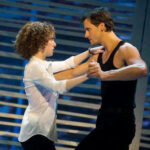Contra dancing is a vibrant and joyful folk dance that welcomes participants of all ages and abilities. Originating in America, it’s enjoyed across the nation and around the globe, often considered a quintessential expression of American folk culture. While sharing some family ties with square dancing, contra dance possesses its own distinct charm and characteristics.
One of the defining features of contra dance is its inseparable connection to live music. Across communities, especially in places like Los Angeles, the tradition of contra dancing is deeply intertwined with the energy and rhythm of live bands.
For newcomers witnessing contra dancing for the first time, a common question arises: “How do people learn these intricate steps?” The answer lies in the role of the “caller.” Before the music begins, the caller guides dancers through the sequence of steps, often walking through the pattern a couple of times. As the music starts, the caller continues to cue the dancers, ensuring everyone stays in sync.
As dancers become more familiar with the patterns, the caller might step back, allowing the flow of the dance and music to take over. Towards the dance’s conclusion, the caller typically rejoins, guiding the dancers to the final moments, often culminating in a celebratory partner swing.
To further enhance accessibility, many contra dances, particularly in locations like Los Angeles, offer beginner workshops. These sessions, usually held about 30 minutes before the main dance, introduce newcomers to the fundamental terminology and movements. Remarkably, this shared vocabulary is consistent across different contra dance communities nationwide. Learning the basics in one place equips you to dance confidently wherever you go.
A key distinction between contra and square dance lies in the formation. Contra dances are performed in long lines of couples facing each other, unlike the square formations of square dance. However, familiarity with square dance terms can be advantageous, as many terms overlap between the two styles. Occasionally, a contra dance caller might even introduce a square dance or two into the evening’s repertoire, adding variety to the experience.
Contra dance footwork is refreshingly simple. Most of the time, it involves walking steps synchronized with the music’s beat. While a few movements might benefit from starting on a specific foot, contra dancing primarily emphasizes body positioning relative to your fellow dancers rather than intricate footwork patterns.
Within the lines, after each complete cycle of the dance pattern, typically spanning 64 musical beats, couples gracefully progress down the line, encountering new partners for the subsequent repetition. Although the patterns are structured, experienced dancers often find moments to inject personal flair, adding spins and twirls as space and timing allow, enhancing the dance’s spontaneous and joyful nature.
To truly grasp the essence of contra dancing, watching it in action is invaluable. Platforms like YouTube host a wealth of videos showcasing contra dances. A simple YouTube search for “Contra Dance” will reveal numerous examples. To learn more about a specific video, explore the uploader information typically found on the right side of the YouTube page.

